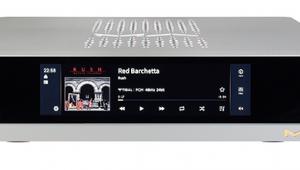Auralic Aries G1.1 Music Library/Server Page 2
Put simply, the Aries G1.1 will make the most of any DAC to which it's connected. Even the cleanest of computer installations is going to sound a little soft and hazy by comparison, presumably thanks to the Aries G1.1's optimised network/USB solution.
Rocking The House
The results are easy to hear with a recording such as the recent remaster of Elton John's Honky Château [Rocket Entertainment/Mercury 4596215], where familiar tracks like 'Honky Cat' and 'Rocket Man' have a crispness, presence and ambience via the Aries G1.1 that's slightly muted when playing into the same DAC directly from a computer. The vocals have better character, and that distinctive piano style is even more apparent, bringing the music up more vibrantly than ever.
That clarity also serves well the recent Pentatone releases of Mahler symphonies by the Czech Philharmonic under Semyon Bychkov. The beautifully open and spacious sound of the Fourth Symphony [Pentatone PTC5186972; 96kHz/24-bit] really illuminates the quality of the performances here, as does the speed and definition with which the frequently changing rhythms are presented. This is a recording with both clarity and a fine dynamic range, and the way it's delivered via the Aries G1.1 makes it a real breath of fresh air, leaving the listener eager to hear more of what promises to be a captivating cycle.
King Of The Slam
Step back in time to the 2014 40th anniversary release of Supertramp's Crime Of The Century album [UMG; 192kHz/24-bit download], and that ability of this digital player to partner with a suitably revealing DAC and dig really deep into a recording is again remarkable. Right from the opening notes of 'School', the Aries G1.1 really brought out the art rock/jazz influences here.

It was enough to have this listener playing this set right the way through before moving on to the massive Breakfast In America, released in 1979 and surely 'peak Supertramp'. And, boy, does the album shine through the Auralic/iFi Audio DAC combo when played in DSD64 from an SACD I picked up some years ago [A&M UIGY-9536]. It may be familiar from multiple plays, but the sequence from 'The Logical Song' through to 'Take The Long Way Home' sounds breathtaking here, with real slam and sparkling vocals and instruments.
There's not so great a change of pace required to reach Michel Camilo's 2005 version of Gershwin's Rhapsody In Blue [Telarc SACD-63611], recorded in Spain with the Barcelona Symphony Orchestra under Ernest Martinez Izquierdo. Given the soloist's background it's wonderful to hear what has become a concert-hall warhorse delivered with so jazzy a lightness of touch from all concerned. And the crispness of the Aries G1.1's sound really brings out the slightly distant orchestra, almost putting the listener on the piano stool as Camilo romps through Gershwin's tight rhythms and exuberant flourishes.
Power Play
This lightness of touch is a hallmark of the Aries G1.1's sound, or rather lack of sound, as it gets out of the way of the music, concentrating on serving it up conveniently and letting the rest of your system do its stuff. It does so as convincingly with the simple, airy sound of Third Reel's Many More Days jazz set [ECM 2431] as it does with the mighty Christopher Jacobson/Orchestre de la Suisse Romande recording of the Saint-Saëns Organ Symphony [Pentatone PTC5186638].
Here the sheer power of the solo instrument is unleashed without restraint in the final movement. In other words, whatever you play, the Aries G1.1 delivers, and when you add in its storage flexibilities, it's quite an all-rounder.
Hi-Fi News Verdict
The beauty of the Aries G1.1 is two-fold: first, its clear, logical control interface makes setup and accessing even extensive music libraries simple, and second, it imposes nothing of itself on what it's playing, rather getting out of the way and letting your DAC do its stuff. Add in the solidity of its design and build, plus the flexibility of its capabilities, and it's a compelling buy for network music playback.























































